Cotton candy
Cotton candy is a spun sugar confection that resembles cotton. It usually contains small amounts of flavoring or food coloring.[1]
Spinning cotton candy at a fair | |
| Alternative names | Candy floss, fairy floss |
|---|---|
| Type | Confectionery |
| Created by | William Morrison and John C. Wharton |
| Main ingredients | Sugar, food coloring |
The candy is made by heating and liquefying sugar, spinning it centrifugally through minute holes—by which the sugar rapidly cools and re-solidifies into fine strands.[2] It is often sold at fairs, circuses, carnivals, and festivals—served in a plastic bag or on a stick or paper cone.[3][4][5]
Cotton candy is made and sold globally—as candy floss in the UK, Ireland, New Zealand, Egypt, India, Sri Lanka, and South Africa, and as fairy floss in Australia.[6] Similar confections include the Indian sohan papdi and the Persian pashmak.
History
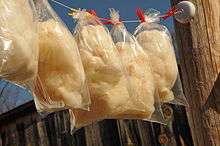
Several places claim the origin of cotton candy, with some sources tracing it to a form of spun sugar found in Europe in the 19th century. At that time, spun sugar was an expensive, labor-intensive endeavor and was not generally available to the average person.[7] Others suggest versions of spun sugar originated in Italy as early as the 15th century.[8]
Machine-spun cotton candy was invented in 1897 by dentist William Morrison and confectioner John C. Wharton, and first introduced to a wide audience at the 1904 World's Fair as "Fairy Floss"[9] with great success, selling 68,655 boxes at 25¢ (equivalent to $7.11 in 2019) per box. On September 6, 1905, Albert D. Robinson of Lynn, Massachusetts submitted his patent for an Electric Candy-Spinning Machine. The patent was for a combination of an electronic starter, motor-driven rotatable bowl, that maintained heating efficiently. By May 1907 he transferred the rights to the General Electric Company of New York. His patent still remains today as the basic Cotton Candy machine.[10]
Joseph Lascaux, a dentist from New Orleans, Louisiana, invented a similar cotton candy machine in 1921. In fact, the Lascaux patent named the sweet confection "cotton candy" and the "fairy floss" name faded away, although it retains this name in Australia.[11][12] In the 1970s, an automatic cotton candy machine was created which made the product and packaged it. This made it easier to produce and available to sell at carnivals, fairs, and stores in the 1970s and on.
Tootsie Roll Industries, the world's largest cotton-candy manufacturer, makes a bagged, fruit-flavored version called Fluffy Stuff.[13]
In the United States, National Cotton Candy Day is celebrated on December 7.[14][15]
Production
Typical machines used to make cotton candy include a spinning head enclosing a small "sugar reserve" bowl into which a charge of granulated, colored sugar (or separate sugar and food coloring) is poured. Heaters near the rim of the head melt the sugar, which is squeezed out through tiny holes by centrifugal force. Colored sugar packaged specially for the process is milled with melting characteristics and a crystal size optimized for the head and heated holes; granulated sugar used in baking contains fine crystals which spin out unmelted, while rock sugar crystals are too large to properly contact the heater, slowing the production of cotton candy.
The molten sugar solidifies in the air and is caught in a larger bowl which totally surrounds the spinning head. Left to operate for a period, the cotton-like product builds up on the inside walls of the larger bowl, at which point machine operators twirl a stick or cone around the rim of the large catching bowl, gathering the sugar strands into portions which are served on stick or cone, or in plastic bags. As the sugar reserve bowl empties, the operator recharges it with more feedstock. The product is sensitive to humidity, and in humid summer locales, the process can be messy and sticky.
Modern innovations in cotton-candy equipment include vending machines which automatically produce single servings of the product, developed in Taiwan,[16] and lighted or glowing sticks.
Flavoring
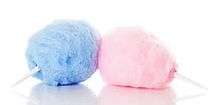
The source material for candy mesh is usually both colored and flavored. When spun, cotton candy is white because it is made from sugar, but adding dye or coloring transforms the color. Originally, cotton candy was just white. In the US, cotton candy is available in a wide variety of flavors, but two flavor-blend colors predominate—blue raspberry and pink vanilla, both originally formulated by the Gold Medal brand (which uses the names "Boo Blue" and "Silly Nilly"). Cotton candy may come out purple when mixed. Cotton candy machines were notoriously unreliable until Gold Medal's invention of a sprung base in 1949—since then, they have manufactured nearly all commercial cotton candy machines and much of the cotton candy in the US.[17]
Typically, once spun, cotton candy is only marketed by color. Absent a clear name other than "blue", the distinctive taste of the blue raspberry flavor mix has gone on to become a compound flavor that some other foods (gum, ice cream, rock candy, fluoride toothpaste) occasionally borrow ("cotton-candy flavored ice cream") to invoke the nostalgia of cotton candy. Pink bubble gum went through a similar transition from specific branded product to a generic flavor that transcended the original confection, and "bubble gum flavor" often shows up in the same product categories as "cotton candy flavor".
Machines
In 1978, the first automated machine was used for the production of cotton candy. Since then, the creations and innovations of this machine have become greater and greater. They range in sizes from counter-top accessible to party and carnival size. Modern machines that are made for commercial use can hold up to 3 pounds (1.4 kg) of sugar and have compartments for storage of extra flavors. The rotating bowl at the top spins at 3,450 revolutions per minute.[18]
Gallery
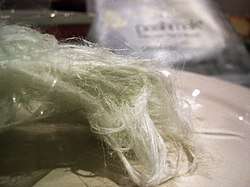 Pashmak, an Iranian type
Pashmak, an Iranian type.jpg) Pişmaniye, a Turkish kind
Pişmaniye, a Turkish kind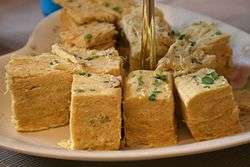 Sohan papdi, an Indian kind
Sohan papdi, an Indian kind- Dragon's beard candy, a Chinese kind
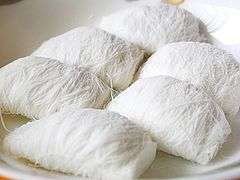 Kkul-tarae, a Korean kind
Kkul-tarae, a Korean kind- Cotton-candy making
- Cotton-candy vendor
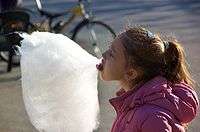 Girl eating cotton candy, Russia
Girl eating cotton candy, Russia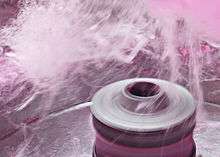 Spinning head of the cotton-candy maker
Spinning head of the cotton-candy maker- Cotton-candy street machine in Poland
See also
References
- Swarns, Rachel L. (July 27, 2014). "In Coney Island, Weaving a Confection That Tastes Like Long-Ago Summers". The New York Times.
- "Food Science: Cotton Candy". Portageinc.com.
- "Best Of Worst -- July 4th Foods". cbsnews.com. July 1, 2008. Archived from the original on October 5, 2008. Retrieved September 13, 2009.
Cotton Candy (1.5 oz serving) 171 calories, 0 g fat, 45 g carbs, 45 g sugar, 0 g protein
- Carter, Darla (August 21, 2009). "Enjoy the fair, but don't wreck your diet". Louisville Courier-Journal. Archived from the original on January 31, 2013. Retrieved September 13, 2009.
A 5½-ounce bag of cotton candy can have 725 calories.
- "Cotton candy on a stick (about 1 ounce) has 105 calories, but when bagged (2 ounces) it has double that number: 210". Pocono Record. September 27, 2006. Retrieved September 13, 2009.
- "The Untold Truth of Cotton Candy". Grunge. Retrieved 2019-01-08.
- Olver, Lynne. "history notes-candy". The Food Timeline. Retrieved November 30, 2011.
- Linda Fri (August 11, 2010). "Cotton Candy History". CottonCandy.net. Retrieved June 28, 2015.
- "Cotton Candy". The Straight Dope. February 7, 2000. Retrieved November 30, 2011.
- Official Gazette of the United States Patent Office. The Office. 1907.
- "History of Cotton Candy". Fineentertaining.com. Retrieved June 28, 2012.
- "Cotton Candy Fun Facts". Archived from the original on July 8, 2011. Retrieved October 24, 2010.
- "Welcome to Tootsie – Product Information – Fluffy Stuff Cotton Candy". Tootsie.com. May 22, 2010. Retrieved November 30, 2011.
- "Breakfast buffet: National cotton candy day". CNN. December 7, 2011. Archived from the original on July 4, 2015. Retrieved July 3, 2015.
- "National Cotton Candy Day is Dec. 7". THV11. December 7, 2011. Archived from the original on March 4, 2016. Retrieved March 13, 2013.
- "VendEver Rolls Out Cotton Candy Machine" (PDF). Vending Times. Archived from the original (PDF) on 2012-04-26. Retrieved 2012-12-17.
- "Who invented cotton candy?". The Straight Dope. 2000-02-07. Retrieved 2017-03-16.
- Venzon, Christine (December 3, 2009). "How Stuff Works Inc. "Cotton Candy Machines and Marketing Today." Howstuffworks.com. Web. September 14, 2011". Science.howstuffworks.com. Retrieved November 30, 2011.
Further reading
- The Complete Confectioners, Pastry, Cook and Baker by M. Sanderson (Philadelphia: Lippincott)
- "History of Cotton Candy". Cotton Candy Express. N.p., n.d. Web. September 14, 2011.
External links

